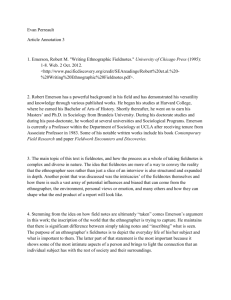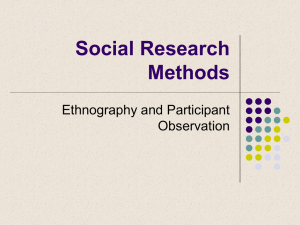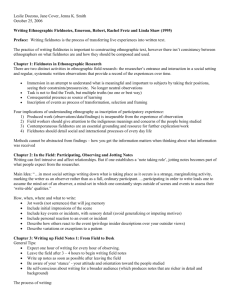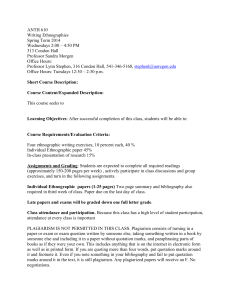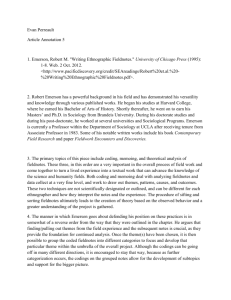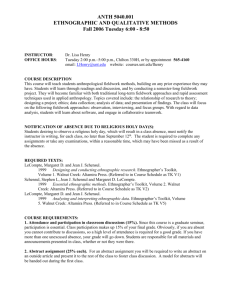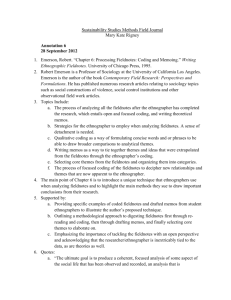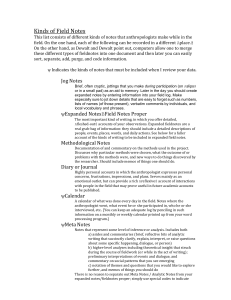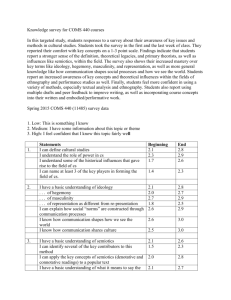On writing fieldnotes: collection strategies and background
advertisement
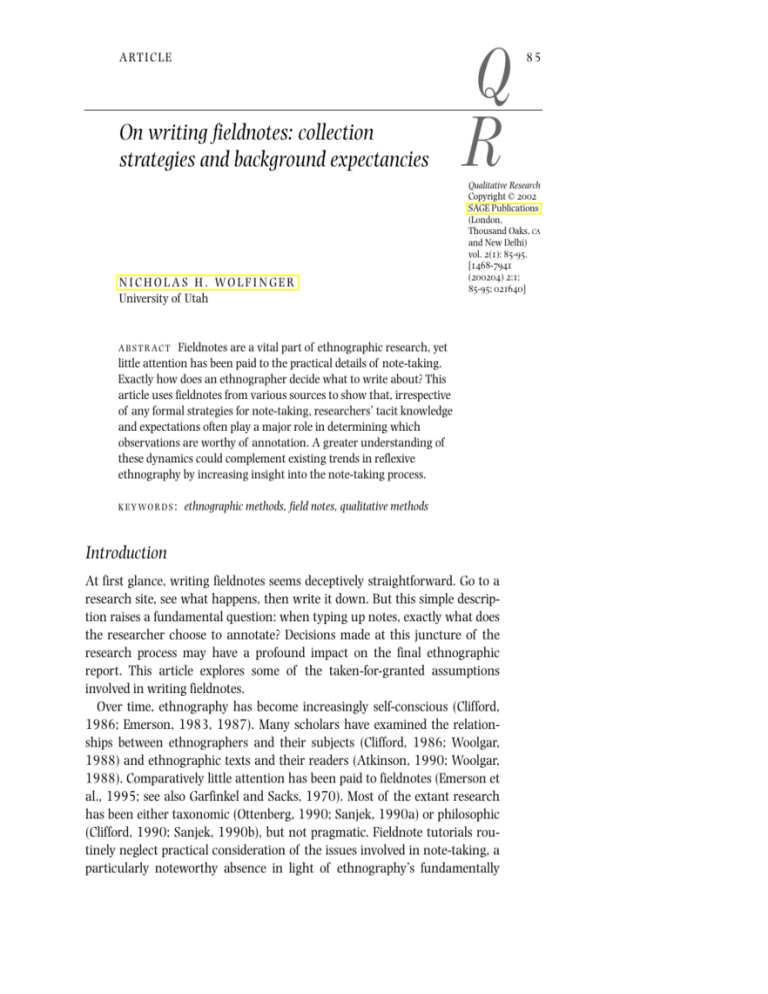
A RT I C L E On writing fieldnotes: collection strategies and background expectancies NICHOLAS H. WOLFINGER University of Utah Q R Qualitative Research Copyright © SAGE Publications (London, Thousand Oaks, CA and New Delhi) vol. (): -. [- () :; -; ] Fieldnotes are a vital part of ethnographic research, yet little attention has been paid to the practical details of note-taking. Exactly how does an ethnographer decide what to write about? This article uses fieldnotes from various sources to show that, irrespective of any formal strategies for note-taking, researchers’ tacit knowledge and expectations often play a major role in determining which observations are worthy of annotation. A greater understanding of these dynamics could complement existing trends in reflexive ethnography by increasing insight into the note-taking process. A B S T R AC T KEYWORDS: 85 ethnographic methods, field notes, qualitative methods Introduction At first glance, writing fieldnotes seems deceptively straightforward. Go to a research site, see what happens, then write it down. But this simple description raises a fundamental question: when typing up notes, exactly what does the researcher choose to annotate? Decisions made at this juncture of the research process may have a profound impact on the final ethnographic report. This article explores some of the taken-for-granted assumptions involved in writing fieldnotes. Over time, ethnography has become increasingly self-conscious (Clifford, 1986; Emerson, 1983, 1987). Many scholars have examined the relationships between ethnographers and their subjects (Clifford, 1986; Woolgar, 1988) and ethnographic texts and their readers (Atkinson, 1990; Woolgar, 1988). Comparatively little attention has been paid to fieldnotes (Emerson et al., 1995; see also Garfinkel and Sacks, 1970). Most of the extant research has been either taxonomic (Ottenberg, 1990; Sanjek, 1990a) or philosophic (Clifford, 1990; Sanjek, 1990b), but not pragmatic. Fieldnote tutorials routinely neglect practical consideration of the issues involved in note-taking, a particularly noteworthy absence in light of ethnography’s fundamentally 86 Qualitative Research 2(1) subjective underpinnings. Van Maanen (1988) provides an eloquent statement of the problem: To put it bluntly, fieldnotes are gnomic, shorthand reconstructions of events, observations, and conversations that took place in the field. They are composed well after the fact as inexact notes to oneself and represent simply one of many levels of textualization set off by experience. To disentangle the interpretive procedures at work as one moves across levels is problematic to say the least. . . . Little wonder that fieldnotes are the secret papers of social research (pp. 223–4). Given that writing is traditionally seen as the linchpin of ethnographic inquiry (see Geertz, 1973), it is important to understand how Van Maanen’s ‘many levels of textualization set off by experience’ affect the note-taking process. Emerson et al. (1995), the only monograph-length treatment of fieldnotes to date, provide much valuable information but treat the selection of experiences for annotation as a process guided by explicit instructions. As such, they gloss over the taken-for-granted mechanisms involved. I aim to show how these mechanisms, operating within formalized instructions for ethnographic scholars, affect the content of fieldnotes. DATA I employ data from two sources. First, I use fieldnotes from my ethnography of public space interaction (Wolfinger, 1995); second, I draw upon ethnographic data produced by others, both published and from graduate classes. Where do fieldnotes come from? When in the field, ethnographers are already deciding what to write about. What do they notice? What do they choose to focus their attention upon? What do they subsequently recall? Of what they remember, what do they choose to document in their notes? In what detail? I begin with an example that reveals the complex relationship between a researcher’s experiences in the field and his or her experiences at the typewriter or word processor. From a student ethnography of supermarket checkout queues: The most populous line unfortunately had only two people in it, one of whom was waiting for the last of her groceries to be bagged and so was not someone I felt I could rely on to contribute significantly to my ‘setting’. I became slightly disappointed at the slimness of my pickin’s [sic] but forged ahead, resolved to make the best of it and also a bit amazed at myself for the degree of preliminary planning and concern I was manifesting. Why didn’t I just get in line and start watching people? A single minute would be more than enough time to produce material to fill pages if I simply gave that minute the opportunity to impress itself upon me. This ethnographer spent a lot of time deciding what to watch. How much of Wolfinger: On writing fieldnotes his equivocation occurred at the time he conducted his observations and how much was recreated when typing up his notes? The last line in the excerpt suggests the latter: the concern of ‘fill[ing] pages’ is specific to the process of writing fieldnotes. How did his deliberation influence his data collection: did he treat the checkout queue he subsequently entered as a different phenomenon because it only had two people in it? Did this influence emerge when he went through the queue or did he just impute it afterwards when typing up his notes? Speculation could continue, but I think the point has been made: what the ethnographer does at the word processor and what he or she does in the field have a meaningful interaction. This idea is not lost on Emerson et al. (1995: 60–1), who describe how ethnographers may let understandings unfold in the course of writing fieldnotes. However, they focus on the rhetorical rather than the substantive implications. How does the process of textual recreation actually affect ethnographers’ experiences, as depicted in their notes? Ethnography places much discretion in the hands of the researcher. Symbolic interactionism (Blumer, 1969), social setting analysis (Lofland and Lofland, 1984) and grounded theory (Charmaz, 1983; Glaser, 1978; Glaser and Strauss, 1967) – three common theoretical warrants for ethnography – argue against the use of field research methods for testing preconceived hypotheses. Instead, these perspectives advocate letting one’s experiences in the field guide a study’s focus. While in the field, researchers presumably identify certain phenomena as interesting and worthy of annotation. They therefore must exercise discretion in deciding what should be documented in their fieldnotes. The sources of this discretion are explored in the following sections of this article. Three practical considerations often shape the course of note-taking. First, a researcher will sometimes be able to take notes while in the field. Many fieldwork texts advocate this practice (Berg, 1989; Emerson et al., 1995; Goffman, 1989; Lofland and Lofland, 1984; Schatzman and Strauss, 1973). These preliminary notes generally form an outline when the researcher sits down at the end of the day to type out complete notes. Second, the focus of an ethnographic investigation typically narrows over time (Hammersley and Atkinson, 1983; Spradley, 1980), obviously influencing what a note-taker chooses to describe. Third, note-taking may be influenced by the perceived audience (Emerson et al., 1995). Within these broad constraints, however, an ethnographer will still have to decide exactly what should be annotated. The role of tacit knowledge in the creation of fieldnotes I contend that tacit knowledge is perhaps the most important consideration in determining how particular observations are deemed worthy of annotation. Ethnographers use what Harold Garfinkel (1967: 78) calls the documentary method of interpretation when they choose to record an observation: 87 88 Qualitative Research 2(1) Social objects . . . are the products of complicated judgements in which an ‘underlying pattern’ is built up from a temporally qualified succession of appearances. . . . Aspects of the process may be brought to consciousness, for example, when we struggle to ‘make out’ what somebody is doing or ‘form hypotheses’ about it (Heritage, 1984: 86). In other words, all social actors actively strive to make informed decisions based upon their background knowledge, knowledge that is, in the words of Garfinkel (1967) ‘seen but unnoticed’ (p. 118). This includes ethnographic note-takers. Although it has been suggested that ethnographic writing depends upon taken-for-granted knowledge (Ely et al., 1991; Emerson, 1983; Kleinman et al., 1997; Pelto and Pelto, 1978), this idea has not been explored thoroughly or has been examined only in specific contexts such as conversation analysis (Watson, 1996). The relationship between tacit knowledge and fieldnotes becomes apparent in considering an example. The following fieldnote describes Spradley’s (1980) summons to a grand jury: There were rows of spectator benches, all made of heavy dark wood, oak or walnut, to match the paneled walls. The rows of benches went for more than twenty-five feet until they met a railing that seemed to neatly mark off a large area for ‘official business’. . . . At the right of the area behind the railing were twelve high-back leather chairs behind another railing. A large oak table with massive chairs all faced toward a high lectern which I took to be the judge’s bench (p. 74, emphasis added). In the last line of this excerpt, Spradley identifies a structure as the judge’s bench. How does he know this? He has background knowledge from three sources: he presumably has some previous exposure to courtrooms, he knows he has been summoned to the grand jury, and he has recorded other observations (of benches, railings, and a jurors’ box) indicating the likely presence of a judge’s bench. Thinking back to his time in the field, his observations resonate with his background knowledge to produce the identification of ‘judge’s bench’. This is a particularly useful example because Spradley himself assists in the argument I propose: by writing ‘which I took to be the judge’s bench’, he acknowledges the interpretive process involved in making an ethnographic observation. Furthermore, Spradley’s analytic self-consciousness shows that the processes of interpretation and identification involved in any ethnographic study can be examined by the researcher. In this instance, it is curious that the judge’s bench was apparently more difficult to identify than any other part of the courtroom. Did this reflect the importance Spradley attributed to the judge in the ensuing legal proceedings, his uncertainty regarding the judicial role in a grand jury hearing, an unexpectedly small lectern, or something else entirely? Presumably only Spradley knows for sure, but either way the answer might tell us more both about the grand jury and how he went about describing his experiences there. Wolfinger: On writing fieldnotes Two strategies for writing fieldnotes When ethnographers type up their fieldnotes they inevitably must make decisions concerning the order in which they will document what happened in the field. Different techniques may be employed, and it is my position that the strategy adopted will influence the ensuing data by determining how tacit knowledge is used in the depiction of people, places and events. Emerson et al. (1995: 48) describe two methods for writing fieldnotes. They are not mutually exclusive, but simply represent two practical approaches to the note-taking process. I will describe these two strategies, then suggest how each might produce different data depending upon an ethnographer’s tacit knowledge and beliefs. S T R AT E G Y O N E : T H E S A L I E N C E H I E R A RC H Y In sitting down to record notes, ethnographers can start by describing whatever observations struck them as the most noteworthy, the most interesting, or the most telling. What might comprise one of these salient episodes? An example from an ethnography of phone sex ‘chat line’ employees: The phone monitors consistently refer to the callers as losers and sometimes as psychos. We answer the phones by releasing mute buttons for our headsets and some monitors use the mute buttons to ridicule the callers while they are still on the line with them. The most common practice is to talk to the caller and quickly press the mute button and say ‘fucking loser’ and then return to the caller. This excerpt conveys an interesting piece of ethnographic information – I assume it is interesting because I found it to be so – so its author may well have been intrigued when she selected it for annotation. Ethnographers may be prepared to describe a number of such events when they sit down to write fieldnotes. These incipient data comprise what I will refer to as a salience hierarchy.1 What makes an observation salient is highly subjective and depends upon the particular research context. Nevertheless, several rules of thumb apply and each demonstrates the role of tacit knowledge in writing fieldnotes. Deviant cases often lead to salient data. Cases may be deviant in at least two ways. First, they may strike researchers as deviant with respect to their tacit expectations. For example, in his study of rural communards, Bennett Berger (1981) only mentions sexual practices that might be seen as deviant by society at large. He doesn’t waste time describing the monogamous sex lives of cohabiting adults. Thus Berger’s background knowledge influenced what he perceived as salient. The aforementioned description of phone sex workers ironically provides a subtler example of this point. The discovery that workers disparage their customers may have seemed noteworthy simply because the ethnographer presumably entered the setting fully aware of how important client relations are to the atmosphere of any retail business. Tacit knowledge may also be developed in situ, so that a case may seem deviant just with respect to others observed. These other cases form the 89 90 Qualitative Research 2(1) contrasts – in other words, the background knowledge – that lead to the identification of certain cases as deviant. This is a desirable occurrence because it can contribute to the development of theory (Katz, 1983). In my study of public space interaction, I found that pedestrians often looked at each other and exchanged pleasantries after narrowly averting a collision. One time a pedestrian addressed me without looking. I found this anomaly interesting and accorded it additional consideration in my fieldnotes: I looked at him (at his face, that is) and said ‘sorry.’ He did not look back at me in mumbling a response, which was something like ‘alright.’ His expression did not change when he said this. In retrospect, the apparent depth of his preoccupation or reverie rendered this exchange memorable – I was struck by it at the time. This fieldnote may not have been written had the pedestrian manifested a more usual reaction to the near-collision. An interaction’s boundaries (temporal, spatial, or otherwise) or absence thereof might also render it memorable. In my study of public space interaction, a memory temporally and spatially contiguous to many others was often less memorable than one occurring on, for instance, an otherwise empty street. In the latter case, there’s simply less mental fodder present to cloud one’s memory when typing up fieldnotes. Ethnographers frequently choose to record a particular observation because it stands out. Observations often stand out because they are deviant, either when compared to others or with respect to a researcher’s existing knowledge and beliefs. Either way, background knowledge influences which cases are chosen for annotation. S T R AT E G Y T WO : C O M P R E H E N S I V E N O T E - TA K I N G An alternate strategy for recording notes is to systematically and comprehensively describe everything that happened during a particular period of time, such as a single trip to the field. Systematic can mean a couple of different things. One place to start is with a generalized list of concerns, such as that provided by Lofland and Lofland (1984: 48): Who is he? What does he do? What do you think she meant by that? What are they supposed to do? Why did she do that? Why is that done? What happens after ________? What would happen if ________? What do you think about ________? Who is responsible if ________? Wolfinger: On writing fieldnotes Spradley (1980: 78) provides a similar list: 1. Space: the physical place or places 2. Actor: the people involved 3. Activity: a set of related acts people do 4. Object: the physical things that are present 5. Act: single actions that people do 6. Event: a set of related activities that people carry out 7. Time: the sequencing that takes place over time 8. Goal: the things people are trying to accomplish 9. Feeling: the emotions felt and expressed Another strategy is to organize one’s note-taking temporally: start at the beginning and end at the end (Emerson et al., 1995). Many social settings have their own unique time-tables (Hammersley and Atkinson, 1983) and these can facilitate note-taking by serving as outlines. Note-taking that attends to the rhythms of its subjects may be more attentive to members’ meanings, a generally desirable objective in ethnography (Emerson, 1983). The comprehensive method of note-taking also has the advantage of forcing an ethnographer to recreate events in the order they really happened. This can aid in the recall of details that might otherwise have been forgotten. Cognitive psychology shows that people tend to retain information in specific ‘knowledge structures’ (Abelson, 1981; Schank and Abelson, 1977). It follows that remembering one aspect of an event might trigger recall of an entire sequence. One text on ethnographic method, cognizant of this, offers the following advice: Concentrate on the first and last remarks in each conversation. Conversations generally follow a logical sequence. That is, a certain question elicits a certain response; a certain remark provokes another; a certain topic leads to a related one. If you can remember how a conversation was initiated, you can frequently follow it through to the end in your own mind (Bogdan and Taylor, 1975: 62; original emphasis). Similarly, Berg (1989: 73) encourages ethnographers to take notes on the sequence of events. How does tacit knowledge affect note-taking when using the comprehensive method? In recounting entire segments of time spent in the field a researcher will often describe events that might otherwise seem too mundane to annotate. These data may later turn out to be valuable, because they can provide the contrasts that allow an ethnographer to identify deviant cases. Whether or not they are identified as such, these cases will form the background knowledge that guides subsequent note-taking. Methodological self-awareness increases because researchers can make their tacit knowledge explicit. In my ethnography of public space I described several interactions that ‘didn’t happen’. This sort of material becomes useful when compared to 91 92 Qualitative Research 2(1) interactions that did happen, because it allows a researcher to develop the criteria for defining an event in any given social setting. Here is an example of an interaction that didn’t happen, that I would not have noted had I just been using the salience hierarchy method: I came to a halt at a red light, still on the curb. Across the street, I saw two studenty looking women. They were obviously poised to cross over to my side of the street when the light turned green. They were positioned far to my right. I looked over at them . . . to assess whether an interaction was forthcoming – whether either I or they would end up negotiating some sort of passage. . . . It quickly became apparent to me that no ‘passage negotiating’ was going to take place. We were too far apart laterally (somewhere between ten and fifteen feet), and this was very apparent to me as I stood still and saw them standing still. Thus, by being still I had the opportunity to assess their intended courses (which they followed), and they presumably had the opportunity to assess mine. The light soon turned green and we all passed, far apart, without exchanging glances. The two women had been talking to each other the entire time. By describing non-interactions, I made explicit some of the criteria for defining an interaction in public space. Another example, from a student ethnography of a supermarket: I move along to the produce area where there are a number of people sorting through the apples, bananas and veggies. I am struck by how normal it all is. . . . No one is particularly interested in the doings of anyone else. Fruit and vegetables are occupying almost everyone’s attention fully. Two young women, dressed in Melrose Ave. style, sweep through the scene, moving rapidly and talking in quiet but rushed voices. No one but me seems to even notice. The setting is almost languid. By documenting omissions, ethnographers convey a more comprehensive depiction of a research site, allowing them to gain valuable insight into the background knowledge that guides subsequent note-taking. This in turn may prove useful in better understanding how and why events take place. Conclusion Fieldnotes are an oft-neglected yet fundamental part of ethnography. They serve the crucial role of connecting researchers and their subjects in the writing of an ethnographic report. Often an ethnographer spends enormous amounts of time writing notes. For these reasons field notes may take on a unique sacredness (Jackson, 1990a, 1990b; Sanjek, 1990b). As Freud might put it, we cathect our notes – they become part of us. Therefore it is important to understand the processes underlying their creation and how these processes can affect ethnographic texts. The advent of reflexive ethnography has drawn attention to the relationship between researchers and their subjects, and that of texts and their readers. Moreover, it is well known that prose inevitably embodies the author’s Wolfinger: On writing fieldnotes tacit convictions; consider, for example, Howard Becker’s (1986) pithy remark in his book on writing for the social sciences: ‘You have already made many choices when you sit down to write, but you probably don’t know what they are’ (p. 17). Fieldnotes, given their importance to ethnographic scholarship, deserve the same self-scrutiny that other prose is routinely subjected to. Fieldnotes inevitably reflect the ethnographer’s background knowledge, or tacit beliefs. In this article I have described some of the ways in which background knowledge might affect the construction of ethnographic notes, particularly subsequent to the decision to employ either the salience hierarchy or comprehensive strategies of note-taking. This decision represents one commonly taken-for-granted feature of ethnography that can easily be made explicit. Within each of these approaches reside more subtle choices. At this juncture the researcher’s tacit knowledge affects which observations will be recorded in fieldnotes. By recognizing some of the assumptions involved, ethnographers can develop a more thorough understanding of their notetaking and ultimately of the social worlds they study. NOTES 1. With apologies to Sheldon Stryker (1980), who gives this useful term an entirely unrelated meaning. AC K N OW L E D G E M E N T S Robert M. Emerson, Jack Katz, Geoffrey Raymond, Andrew L. Roth and the Interaction Order paper reading group at UCLA provided valuable comments on previous drafts. I also thank Pamela Lytle, Marc Smith and Darin Weinberg for sharing their fieldnotes with me. Finally I extend my appreciation to Angela Casady for research assistance and the Bireley Foundation for its generous support during the latter stages of this research. REFERENCES Abelson, Robert P. (1981) ‘Psychological Status of the Script Concept’, American Psychologist 36: 715–29. Atkinson, Paul (1990) The Ethnographic Imagination: Textual Constructions of Reality. London: Routledge. Becker, Howard S. (1986) Writing for Social Sciences: How to Start and Finish Your Thesis, Book, or Article. Chicago: University of Chicago Press. Berg, Bruce L. (1989) Qualitative Research Methods for the Social Sciences. Needham Heights, MS: Allyn and Bacon. Berger, Bennett M. (1981) The Survival of a Counter Culture. Berkeley, CA: University of California Press. Bogdan, Robert and Taylor, Steven J. (1975) Introduction to Qualitative Research Methods: A Phenomenological Approach to the Social Sciences. New York: Wiley. Blumer, Herbert (1969) Symbolic Interactionism: Perspective and Method. Englewood Cliffs, NJ: Prentice-Hall. Charmaz, Kathy (1983) ‘The Grounded Theory Method: An Explication and 93 94 Qualitative Research 2(1) Interpretation’, in R.M. Emerson (ed.) Contemporary Field Research, pp. 109–226. Prospect Heights, IL: Waveland Press. Clifford, James (1986) ‘Introduction: Partial Truths’, in J. Clifford and G.E. Marcus (eds) Writing Culture: The Poetics and Politics of Ethnography, pp. 1–26. Berkeley: University of California Press. Clifford, James (1990) ‘Notes on Fieldnotes’, in R. Sanjek (ed.) Fieldnotes: The Makings of Anthropology, pp. 47–70. Ithaca, NY: Cornell University Press. Ely, Margot, Anzul, Margaret, Friedman, Teri, Garner, Diane and McCormack Steinmetz, Ann (1991) Doing Qualitative Research: Circles within Circles. London: Falmer. Emerson, Robert M. (1983) ‘Introduction’, in R.M. Emerson (ed.) Contemporary Field Research, pp. 1–35. Prospect Heights, IL: Waveland Press. Emerson, Robert M. (1987) ‘Four Ways to Improve the Craft of Fieldwork’, Journal of Contemporary Ethnography 16: 69–87. Emerson, Robert M., Fretz, Rachel I. and Shaw, Linda L. (1995) Writing Ethnographic Fieldnotes. Chicago: University of Chicago Press. Garfinkel, Harold (1967) Studies in Ethnomethodology. Oxford: Polity Press. Garfinkel, Harold and Sacks, Harvey (1970) ‘On Formal Structures of Practical Actions’, in J.C. McKinney and E.A. Tiryakian (eds) Theoretical Sociology, pp. 337–66. New York: Appleton. Geertz, Clifford (1973) The Interpretation of Cultures. New York: Basic Books. Glaser, Barney G. (1978) Theoretical Sensitivity. Mill Valley, CA: Sociological Press. Glaser, Barney G. and Strauss, Anselm L. (1967) The Discovery of Grounded Theory: Strategies for Qualitative Research. Chicago: Aldine. Goffman, Erving. (1989) ‘On Fieldwork’, transcribed and edited by Lyn Lofland. Journal of Contemporary Ethnography 18: 123–32. Hammersley, Martyn and Atkinson, Paul (1983) Ethnography: Principles in Practice. London: Tavistock. Heritage, John (1984) Garfinkel and Ethnomethodology. Oxford: Polity Press. Katz, Jack (1983) ‘A Theory of Qualitative Methodology: The Social System of Analytic Fieldwork’, in R.M. Emerson (ed.) Contemporary Field Research, pp. 127–48. Prospect Heights, IL: Waveland Press. Kleinman, Sherryl, Copp, Martha A. and Henderson, Karla A. (1997) ‘Qualitatively Different: Teaching Fieldwork to Graduate Students’, Journal of Contemporary Ethnography 25: 469–99. Jackson, Jean E. (1990a) ‘“Déjà Entendu” – the Liminal Qualities of Anthropological Fieldnotes’, Journal of Contemporary Ethnography 19: 8–43. Jackson, Jean E. (1990b) ‘“I am a Fieldnote”: Fieldnotes as a Symbol of Professional Identity’, in R. Sanjek (ed.) Fieldnotes: The Makings of Anthropology, pp. 3–33. Ithaca, NY: Cornell University Press. Lofland, John and Lofland, Lyn (1984) Analyzing Social Settings, 2nd edn. Belmont, CA: Wadsworth. Ottenberg, Simon (1990) ‘Thirty Years of Fieldnotes: Changing Relationships to the Text’, in R. Sanjek (ed.) Fieldnotes: The Makings of Anthropology, pp. 139–60. Ithaca, NY: Cornell University Press. Pelto, Pertti J. and Pelto, Gretel H. (1978) Anthropological Research: The Structure of Inquiry, 2nd edn. London: Cambridge University Press. Sanjek, Roger (1990a) ‘A Vocabulary for Fieldnotes’, in R. Sanjek (ed.) Fieldnotes: The Makings of Anthropology, pp. 92–121. Ithaca, NY: Cornell University Press. Sanjek, Roger (1990b) ‘Fire, Loss, and the Sorcerer’s Apprentice’, in R. Sanjek (ed.) Wolfinger: On writing fieldnotes Fieldnotes: The Makings of Anthropology, pp. 34–44. Ithaca, NY: Cornell University Press. Schank, Roger C. and Abelson, Robert P. (1977) Scripts, Plans, Goals, and Understanding. Hillsdale, NJ: Erlbaum. Schatzman, Leonard and Strauss, Anselm L. (1973) Field Research: Strategies for a Natural Sociology. Englewood Cliffs, NJ: Prentice-Hall. Spradley, James P. (1980) Participant Observation. New York: Holt, Rinehart & Winston. Stryker, Sheldon (1980) Symbolic Interactionism: A Social Structural View. Menlo Park, CA: Benjamin/Cummings. Van Maanen, John (1988) Tales of the Field: On Writing Ethnography. Chicago: University of Chicago Press. Watson, Graham (1996) ‘Listening to the Native: The Non-Ironic Alternative to “Dialogic” Ethnography (as well as to Functionalism, Marxism, and Structuralism’, Canadian Review of Sociology and Anthropology 33: 73–86. Wolfinger, Nicholas H. (1995) ‘Passing Moments: Some Social Dynamics of Pedestrian Interaction’, Journal of Contemporary Ethnography 24: 323–40. Woolgar, Steve (1988) ‘Reflexivity is the Ethnographer of the Text’, in S. Woolgar (ed.) Knowledge and Reflexivity: New Frontiers in the Sociology of Knowledge, pp. 14–34. London: Sage. N I C H O L A S H . W O L F I N G E R is Assistant Professor of Human Development and Family Studies and Adjunct Assistant Professor of Sociology at the University of Utah. His interests include divorce, social demography and research methods. He has written a book on the intergenerational transmission of divorce (Stanford University Press, forthcoming). Address: Department of Family and Consumer Studies, 225 South 1400 East, Room 228, University of Utah, Salt Lake City, UT 84112–0080, USA. [email: nick.wolfinger@fcs.utah.edu] 95
